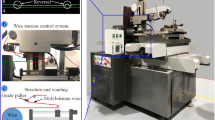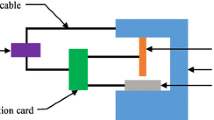Abstract
It is well known that it is hard for convention machining techniques to cut Inconel 718 because of Inconel 718 mechanical properties. Electrical discharge machining (EDM) has two remarkable properties. One is that it can machine any electric conduction material; the other is its noncontact machining which generates no forces in machining. However, the Inconel 718 properties have caused a contradiction in machining Inconel 718. The high melting point of Inconel 718 requires using large EDM discharging energies, while low thermal conductivity restricts the use of large discharging energies because after a series of pulse discharging, the temperature rises so fast to make the deionization of the liquid incomplete, the consequence of which could give rise to generation of arcing pulses which make the machining unstable. To solve this contradiction, this paper first proposed to use variance of machining states to be an index to reflect the difficulty of machining any kind of material. Then, machining state expectation was used to balance machining stableness and machining efficiency. Finally, an adaptive gap servo-voltage control system was constructed where gap servo-voltage was regulated so that machining states could follow the machining state expectation in machining. In this way, the contradiction could be solved, and the verification test in experiment proved this fact.













Similar content being viewed by others
Abbreviations
- τdeleterious :
-
An accumulated number of stable arc pulses and short pulses sampled
- τeffective :
-
An accumulated number of spark pulses and transient arc pulses sampled
- τdelay :
-
An accumulated number of delay pulses sampled
- σ(t):
-
Machining state
- e(t):
-
White noise
- σe(t):
-
Machining state expectation
- θ :
-
Parameter vector of EDM process model
- \( \hat{\theta}(t) \) :
-
Estimate parameter vector of EDM process model
- R :
-
Polynomial of a shifting operator q
- S :
-
Polynomial of a shifting operator q
- T :
-
Polynomial of a shifting operator q
- Usv(t):
-
Gap servo-voltage
References
Liao YS, Lin HM, Wang JH (2008) Behaviors of end milling Inconel 718 superalloy by cemented carbide tools. J Mater Process Technol 201:460–465
Baghlania V, Mehbudia P, Akbarib J, Sohrabic M (2013) Ultrasonic assisted deep drilling of Inconel 738LC superalloy. Proc CIRP 6:571–576
Ahman M, Seah WKH, Teo TT (1997) The machinability of Inconel 718. J Mater Process Technol 63:199–204
Sharman ARC, Hughes JI, Ridgway K (2004) Workpiece surface integrity and tool life issues when turning Inconel 718™ nickel based superalloy. Mach Sci Technol 8:399–414
Liao YS, Lin HM, Wang JH (2008) Behaviors of end milling Inconel 718 superalloy by cemented carbide tools. J Mater Process Technol 201:460–465
Zhou M, Mu X, He L, Ye Q (2019) Improving EDM performance by adapting gap servo-voltage to machining state. J Manuf Process 37:101–113
Uhlmann E, Domingos DC (2013) Development and optimization of the die-sinking EDM-technology for machining the nickel-based alloy MAR-M247 for turbine components. Procedia CIRP 6:180–185
Kliuev M, Boccadoro M, Perez R, Dal Bó W, Stirnimann J, Kuster F, Wegener K (2016) EDM drilling and shaping of cooling holes in Inconel 718 turbine blades. Proc CIRP 42:322–327
Jadam T, Datta S, Mahapatra SS (2018) Electro-discharge machining of Inconel 718 using square cross sectioned copper tool electrode: studies on topography and metallurgical features of the EDMed work surface. Mater Today: Proc 5:4847–4854
Kuppan P, Rajadurai A, Narayanan S (2008) Influence of EDM process parameters in deep hole drilling of Inconel 718. Int J Adv Manuf Technol 38:74–84
Sahu BK, SauravDatta SSM (2018) On electro-discharge machining of Inconel 718 super alloys: an experimental investigation. Mater Today: Proc 5:4861–4869
Hsue AW-J, Chang Y-F (2016) Toward synchronous hybrid micro-EDM grinding of micro-holes using helical taper tools formed by Ni-Co/diamond Co-deposition. J Mater Process Technol 234:368–382
Moghaddam MA, Kolahan F (2014) An empirical study on modeling and optimization of EDM process parameters for Inconel 718 super alloy using D-optimal approach and genetic algorithm. 3th International Engineering Materials & Metallurgy Conference. p. 1–10
Pushpendra A, Bharti S, Maheshwari S, Sharma C (2012) Multi-objective optimization of electrical discharge machining process using controlled elitist NSGA-II. J Mech Sci Technol 26(6):1875–1883
Kunieda M, Lauwers B, Rajurkar KP, Schumacher BM (2005) Advancing EDM through fundamental insight into the process. CIRP Ann Manuf Technol 54(2):64–87
Zhou M, Han F, Soichiro I (December 2008) A time-varied predictive model for EDM process. Int J Mach Tools Manuf 48(15):1668–1677
Zhou M, Han F (2009) Adaptive control for EDM process with a self tuning regulator. Int J Mach Tools Manuf 49:462–469
Wu J, Zhou M, Xu X et al (2015) Fast and stable electrical discharge machining (EDM). Mech Syst Sign Process 72:420–431
Zhou M, Wu J, Xu X, Mu X, Dou Y (2017) Significant improvements of electrical discharge machining performance by step-by–step updated adaptive control laws. Mech Syst Sign Process. https://doi.org/10.1016/j.ymssp.2017.06.041
Ho KH, Newman ST (2003) State of the art electrical discharge machining (EDM). Int J Mach Tool Manu 43:1287–1300
Zhou M, Xin M, Liang H, Ye Q (2019) Improving EDM performance by adapting gap servo-voltage. J Manuf Process 37:101–113
Zhou M, Han F, Wang Y, Soichiro I (2009) Assessment of the dynamical properties in EDM process-detecting deterministic nonlinearity of EDM process. Int J Adv Manuf Technol 44:91–99
Ljung L (1999) System identification—theory for the user, seconded, Prentice-Hall PTR
Astrom KJ, Wittenmark B (1995) Adaptive control, 2nd edn. Addison-Wesley, Reading
Funding
This research has been supported by “The Fundamental Research Funds for Beijing Universities (Nos. X18082 and X18246)” and “Beijing Education Committee Scientific Plan Foundation (No. 051101904)”.
Author information
Authors and Affiliations
Corresponding author
Additional information
Publisher’s note
Springer Nature remains neutral with regard to jurisdictional claims in published maps and institutional affiliations.
Rights and permissions
About this article
Cite this article
Zhou, S., Yang, Y., Zhou, M. et al. Electrical discharge machining Inconel 718 with adaptively regulating gap servo-voltage. Int J Adv Manuf Technol 109, 2575–2585 (2020). https://doi.org/10.1007/s00170-020-05835-4
Received:
Accepted:
Published:
Issue Date:
DOI: https://doi.org/10.1007/s00170-020-05835-4




